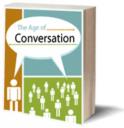 Today I am reviewing the book Taking Care of the People Who Matter Most by Sybil Stershic. The main premise of the book is this: take care of your employees, and they will take care of your customers! In seven easy-to-read chapters, Sybil describes how to do this using an “internal marketing” approach. She helps companies see how to really engage employees so they become committed to the cause, not compliant (doing it because they have to). Believe me, customers can tell the difference!
Today I am reviewing the book Taking Care of the People Who Matter Most by Sybil Stershic. The main premise of the book is this: take care of your employees, and they will take care of your customers! In seven easy-to-read chapters, Sybil describes how to do this using an “internal marketing” approach. She helps companies see how to really engage employees so they become committed to the cause, not compliant (doing it because they have to). Believe me, customers can tell the difference!
Here is a great quote from the first chapter:
“Think about it: most products and services can easily become commoditized, but competitors cannot duplicate the relationship an organization’s employees have with its customers.”
The book goes on to describe how to improve relationships, including employee-employee, employee-management, and employee-customer. People will make the difference, and Sybil gives us a lot of great ideas on both why and how to make them a priority. Coming from my customer-centric perspective, I especially liked Chapter 4 on strengthening the internal service culture. It is so important for each employee to understand why they make a difference in the organization and how that is ultimately reflected out to customers. A strong internal service culture, Sybil suggests, will help improve both employee and customer loyalty. I wholeheartedly agree!
For those of skeptics out there, Sybil includes answers to some “tough questions” in Chapter 6, such as this one: “Do happy employees ensure happy customers?” They are great for arming oneself before attempting to start an employee-loyalty initiative at a business. The book also has several helpful worksheets and charts to assist in planning out the changes that need to be made within a company. Thank you, Sybil, for making it easy to follow!
Q&A
Speaking of questions, Sybil was kind enough to answer a few of my own. Here is the Q&A I had with her about the book.
- Whose job is it to do “internal marketing”? How does it relate to those doing “external marketing”?
Let me start by explaining marketing in both contexts. You can use it to basically communicate with, educate, and motivate employees, just like it’s used to communicate with, educate and motivate consumers. But while external marketing is usually the responsibility of marketing and/or communications staff, internal marketing is an intrinsic part of management’s job – taking care of the employees so they can take care of the customers. So it’s not really a pure marketing function, which is why I tell people you don’t have to be a marketer to apply internal marketing.
- Disney has “cast members”. Starbucks has “partners”. Does what we call our employees really matter? Why would customers care?
Interesting question, Becky. The reality is regardless of how you refer to employees – be it “Associates” … “Team members” … or some other company or brand-relevant name – it doesn’t matter to customers. (And customers will likely call them “employees” anyway.) However, it DOES matter to employees as it sets expectations about the organization’s culture and values. Employees, as well as customers, are quick to see through the rhetoric of employee labels that are merely window dressing.
- It has been said you should inspect what you expect. How do you measure the success of internal marketing – both from the employee as well as from the customer perspective?
Since internal marketing involves engaging employees and customers, you can evaluate it with the same metrics that measure overall satisfaction and retention for both groups. You can also measure specific internal marketing activities (such as recognition programs, new staff orientation, special events, etc.) through quantitative and qualitative means; i.e., who/how many participated, how did it impact their perceptions and/or behavior?
For companies just getting started with internal marketing, it may be the first time the folks from HR and Marketing Research get together to discuss what benchmarks are available from employee and customer surveys. (Note: For companies that have not done any such surveys, please know there are research providers who measure employee engagement and those who also do “linkage research” which looks at operational practices and employee perceptions and links this information to drivers of customer satisfaction.)
- How can a strong service culture help grow customer loyalty and improve the customer experience?
Internal service drives external service – when employees take care of each other’s business needs, everyone is better prepared to take care of the external customer.
Here’s another way to look at it – since customers’ perceptions and intentions are affected by what employees experience on-the-job, the way your employees feel is the way your customers will feel. And if your employees don’t feel valued, neither will your customers!
- For my final question… what is the best customer experience you have ever had?
I was accompanying my husband on a business trip when I suddenly became ill on the plane – a situation that required emergency surgery. When our plane landed in Boston, we were met by ambulance and rushed to a nearby hospital. In between the admissions process and surgery, my husband and I looked at each other and wondered what had happened to our luggage. Since we had gone from the plane to the ambulance, we hadn’t time to get to baggage claim.
While I was undergoing surgery, my husband checked into our hotel and explained the situation. The hotel staff immediately called the airport to find our luggage and have it set aside for us. They had a hotel limo drive my husband back to the airport to get our luggage, after which my husband was dropped off at the hospital to wait for me after surgery, and our luggage was placed in our hotel room prior to my husband’s return that evening. We experienced truly extraordinary service provided by the hotel in a situation that had nothing to do with the hotel.
Here’s what I learned from that experience: customers expect a company to be responsive and “recover” any problems created by service delivery failure … but we can’t always expect the same when the problem is out of the company’s control. Nonetheless, hotel staff went out of their way to help their guests who found themselves in a difficult situation.
The hotel was the Marriott at Boston’s Copley Plaza, and it provided one of my most memorable customer experiences. I’ve shared this story in countless presentations since this experience happened more than 20 years ago! (How’s that for word-of-mouth? Amazing how customers have long memories for positive and negative experiences.)
Thanks for asking, Becky. And thanks for a great interview.
- Thank you, Sybil, for your time!
Blog Book Tour Continues
Sybil’s book tour has already had a few stops this week and finishes up the beginning of next week. Here is her full itinerary; be sure to linger at each stop, since each blog author is coming from a different perspective!
- On June 1st, Kevin Burns posted a review in Burns Blogs Attitude.
- On June 3rd, Lisa Rosendahl posted a review of Taking Care on her blog HR Thoughts, using these eleven words to sum it up: “The way your employees feel is the way your customers feel.”
- On June 4th, Chris Bailey posted a review of Sybil’s book on his blog Bailey Work/Play: The Alchemy of Soulful Work
- On June 5th, Toby Bloomberg posted Virtual Book Tour: A Conversation With Sybil Sterschic, a thought-provoking interview with Sybil on the Diva Marketing blog. She’s also offering a free book giveaway for the reader who adds most to the conversation started in the post through a comment.
- YOU ARE HERE: On June 6th, Becky Carroll, the blogger behind Customers Rock! will be posting a review and the results of an interview with Sybil.
- On June 9th, Paul Hebert will be posting a review on the blog Incentive Intelligence.
- On June 10, 2008, Phil Gerbyshak will be posting an interview on the blog Slacker Manager.


















